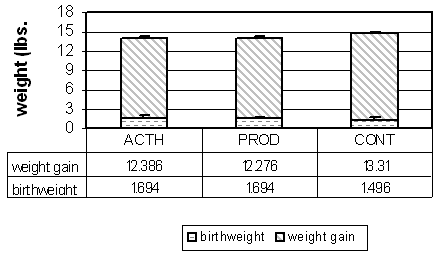
M.T. Toscano and D.C. Lay, Jr.
Agricultural Research Service-USDA, West Lafayette, IN
How an animal responds to stress varies tremendously from animal to animal and is likely a combination of several factors, including previous experiences, age, and pre-natal stress. Pre-natal stress, or stress that is applied to the pregnant dam which can then affect her resulting offspring, is a phenomenon that our lab has taken a central role in investigating. Research in other species, including rodents, cattle, and poultry suggest that pre-natal stress is indeed a potent factor in affecting offspring; however, no information exists in swine.
We are currently in the process of finishing a two year project on this topic. Our study involved an injection of adrenocorticotropic releasing hormone (ACTH) or a broader activation of the stress response with a rough handling (ROU) procedure. Treatments were applied to individually housed pregnant sows during a period of gestation believed to be critical to the development of tissues that have a primary role in the stress response. A third group served as a control (CONT) and were maintained in the same stalls and area. A variety of measures were taken from birth to slaughter and included production data, immune function, and sexual development. At birth, CONT pigs tended to have lower weights than the ACTH and ROU group (P<0.03), although this weight difference reversed itself by weaning (approximately d 21) with the CONT gaining more and having greater weaning weights than the ACTH and ROU groups (Fig. 1). Treatment had no effect on weight gain from weaning to slaughter. Following weaning, ACTH and ROU pigs had greater hematocrit and hemoglobin levels than the CONT group. In response to being regrouped at 4 months of age, granulocytes as a percentage of white blood cells were least in the ACTH group followed by the CONT and ROU groups (P<0.05). During this same period, lymphocytes and monocytes as a percentage of all white blood cells was least in the ROU group followed by CONT and ACTH groups (ACTH vs. CONT, P<0.06; ACTH vs. ROU, ROU vs. CONT; P<0.03). At birth, male ano-genital distance was greater in CONT pigs (p<.0001). We are currently in the process of analyzing data regarding behavioral interactions, weight of stress responsive tissues, expression of stress related hormones, and other data which will provide a more complete picture of the effects of pre-natal stress.
Our results suggest that pre-natal stress has far-reaching implications on a variety of parameters in swine development and the post-natal stress response. The interaction of treatment and age, i.e., differences in birth and weaning weights yet no difference at slaughter, suggest that the effects of pre-natal stress are dynamic and continually changing. Additionally, the differences seen between the ACTH and ROU groups suggest that a mechanism beyond altered maternal glucocorticoid concentrations may be responsible for the effects.
